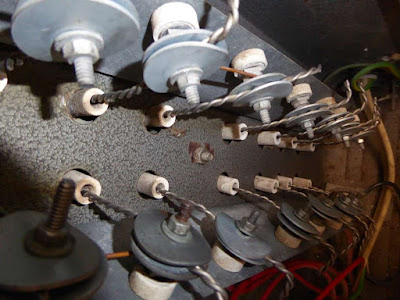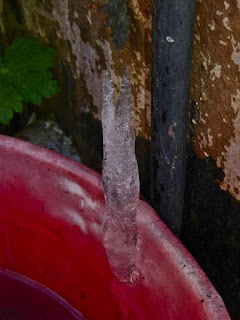Contacting Elephants! Or should I say, Contactors and Elements? Everything Stops for Tea!
Crystalline glazing is hard on electric kilns, the firings are high, hot and long and the electronic goodies that regulate the kiln temperature, and the elements that heat the kiln, have to be replaced far more frequently than for regular glaze firings.
 |
| Replacing "Elephants" |
When I was starting a bisque firing a few weeks ago the sound of the electric kiln at work seemed louder than usual. I listened for a few cycles of it turning on and off, and was aware of something smelling hot, a rather industrial aroma with a definite hint of warm plastic or rubber. I was just at the point of deciding that something really was wrong, when there was a loud continuous buzzing sound, then silence, and a sinister thin column of grey smoke issued from the box of electrical stuff on the side of the kiln!
**Note to self, when a kiln sounds louder than usual accompanied by a smell of hot plastic, then switch everything off immediately!**
After shutting off power at the wall and at the fuse box, and making sure that the smoke had gone away, I made a cup of tea and sat down with it on a comfortable seat outside in the morning sunshine. A cup of tea is wonderfully soothing at times like this.
 |
| Testing Sir Frank Whittle's Turbojet |
What really must be the most splendid example I have ever seen of a cup of tea offered at a time of crisis was on a documentary film about the invention of the jet engine. In one of the first tests of Sir Frank Whittle's turbojet engine, a group of "boffins" gather together in what looks like a garage. The device takes center stage, this "apple of the inventor's eye" is not a thing of beauty, but looks more like junk sculpture made from discarded heavy vehicle exhaust systems and plumbing fittings. It is connected by various cables and wires to levers and control valves, and to soup plate sized dials on the wall. Most of this objet d'art is abstract, but there is something recognizable after all at what must be the front end, in the form of a vehicle radiator with a small engine behind it.
The small engine is started, and this begins to stir the unseen inner workings of the device. A dial on the wall reads out the revolutions per minute as the speed slowly increases. After a wait for the needle to reach a predetermined point on the dial someone turns on a fuel valve, and the thing wakes from its slumbers with a low moaning sound that rises in pitch through the scale until it is a sinister howl. The camera flits from RPM gauge to the boffins. 10000 RPM is reached, the howling grows higher and the boffins become visibly agitated. Someone darts forward to the controls and fuel is shut off, but alas, instead of slowing down, the awful cry gets higher and louder as the thing revs faster and faster. The monster has come alive! Fearing immanent failure of the turbine blades the boffins step back in alarm, and at that moment an internal door to the room opens, and in comes a lady with a trolley arranged with tea pot, cups and saucers, a milk jug, a sugar bowl, and probably a napkin or two!
Happily, seconds later the fuel is exhausted, and the banshee wail slides back through the octaves.
In the immortal words of Jack Buchanan concerning the English love of tea (Everything Stops for Tea)
"Oh, the factories may be roaring
With a boom-a-lacka, zoom-a-lacka, wee
But there isn't a roar when the clock strikes four
Everything stops for tea"
 |
| The Dead Contactor |
Examination of the scene of the crime revealed that the contactor had got very hot indeed, and was most certainly the source of the smoke and the unpleasant smell. I sent off an email to the ever helpful Rob Duggan of Cobcraft Manufacturing Ltd, who make kilns in Rangiora near Christchurch New Zealand, and ordered a replacement part.
The contactor switches the power to the elements on and off. If using a controller, you will hear the contactor working hard as the controller uses this to regulate temperature. If not using a controller and doing things manually, then you will use the simmerstats (infinite switches) on the kiln (rather like the regulator knobs on an electric stove), to do the job. This is much kinder to the contactor, but does wear out the simmerstats instead! Given that contactors are a lot more expensive than simmerstats, I am considering doing as much as I can of the crystalline glaze firings manually, and using my controller for more straight-forward firings.
Whilst waiting for a replacement contactor of the larger of the two electric kilns that I have, I used the smaller kiln to do several manually controlled crystalline glaze test firings. The kiln worked fairly well for regular firings, and would have gone on for several more months, but the elements proved really too worn to keep up a rapid enough rate of temperature rise for crystalline glaze firings, so I "bit the bullet", as they say, and ordered a new set of elements for that kiln as well as the contactor for the other one. An expensive week, but I must say that the performance of the small kiln is much improved by the new elements, its rate of climb is 30 percent faster.
 |
| Replacing Elements |
Sadly, there is no way round this, but crystalline glaze firings are costly firings... and the news is worse still as they also have to be ones where the kiln is only lightly loaded with pots, preferably without kiln shelves, but sometimes you will manage with one shelf or a half shelf if the kiln is performing well. The kiln has to behave like a sports car or race horse. It has to climb energetically to temperature, usually cone 9 - 10, drop to the crystal growing temperature rapidly, then be able to hold for several hours at around 1100 Celsius (2012F). In America there are kilns specially made for crystalline glaze firing that have long lasting mercury relays, extra heavy duty elements, and the kilns are designed to fire to cone 12 or more very quickly indeed. Amazing really, but not readily available in this part of the world, so we do what we can with what we have got!
I am happy to say that the octagonal Cobraft kilns are simple, rugged, do genuinely reach cone 10, and being equipped with a heavy gauge stainless steel case, they last and last and last. I'm not sure how old my one is, but I would guess 30 years would be fairly close.
 |
| Threading element wires through porcelain tubes to their connectors. |
Replacing elements on these kilns is fairly simple, but care has to be taken when threading the element wire through the porcelain tubes that pass from the inside of the kiln to the wiring box on the outside. It is easy to damage the tubes so care must be taken to avoid transmitting any bending load to them. Pliers are essential!
Apologies that this post has been more of "before we begin", but it does illustrate some more of the practical realities of crystalline glazing!


Comments
I went through a stage where messages that I was writing frequently vanished into thin air... Sometimes I wonder if they are still out there, in some sort of orbit in cyberspace. You have my sympathies, it is most frustrating when messages evaporate like that! Thanks for trying again!
I'll see if I can get a good photo of Laura's new work, it is amazing what she is doing right now, and she was back outside this afternoon working on a drawing of our very last sunflower of the season.
Fortunately the contactor for this kiln was around the $200 mark, but it is a fairly small kiln. I think yours is 3 phase and much bigger if I remember rightly? I remember a potter who worked exclusively at earthenware telling me that her elements lasted about 30 years before she finally had to think of replacing them when firings became ultra long and the kiln would barely gasp its way to 1100 C! I have heard of potters doing high fired crystalline glaze replacing elements every 20 to 30 firings..., but I definitely would hope to make them last longer than that! I am contemplating trying some cone 6 crystalline work when the elements get too tired for high firing, that might be a good way to go.
Maybe Bonkers is feeling the effects of Spring! At the other side of the world Mr Smaug was in a particularly playful mood this morning, his latest craze is playing with water! He likes me to put water into an old sink that we have outside, then to let it out a bit at a time. The water gurgles down a short length of pipe then splashes out onto the ground, and he chases the little streams of water and sometimes pats them with his front paws. It is most entertaining! He would like to play that game several times a day!
Hi Gwynneth,
It is certainly fortunate that there are still parts for these kilns. I'm not sure what will happen when Rob from Cobcraft retires (hopefully still some years away!), but it would be possible to source most things from electrical parts suppliers. The elements would have to be made specially though. I have heard of potters winding their own elements back in "the good old days", so where there is a will there is a way!
Fake Van Gogh and white clay from Australia..., I do hope that the tonne of white clay turns out to be the real stuff!! :-)
It does feel quite a difficult decision to make stocking up with raw materials at a time like this, but it is good to keep on making things, and the world will settle back onto a level keel again one day!
Hello Sandy Miller,
Very good to hear from you. Oh dear, you too have stampeding elephants..., cups of tea are certainly a good way of putting off the horrible deed of bending over kilns and doing battle with their innards! Probably a good book could join the cup of tea, and maybe a slice or two of cake..., and another cup of tea to chase it down! Yawn! Zzzzzzz..... It is amazing where the time goes when there are elements to change!
All the very Best :-)
I did enjoy reading about the pheasants and certainly not a common sight in NZ, although we were very surprised 2 or 3 years ago to see one at the other side of the main road that runs past our place. Saw a Kingfisher this morning in one of our trees. We see them here from time to time, as we are close to "Post Office Creek" which ranges in identity from stream to storm water drain, I think Kingfishers are a bit optimistic looking for fish here!